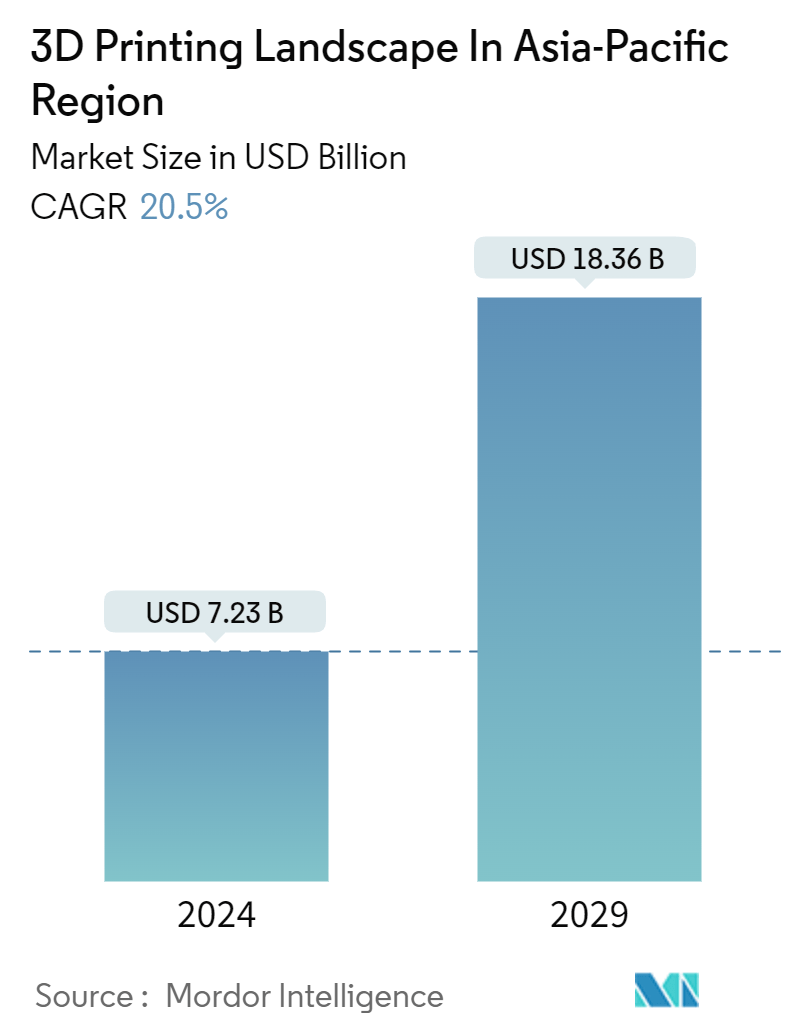
| Study Period | 2022 - 2029 |
| Base Year For Estimation | 2023 |
| Forecast Data Period | 2024 - 2029 |
| Market Size (2024) | USD 7.23 Billion |
| Market Size (2029) | USD 18.36 Billion |
| CAGR (2024 - 2029) | 20.50 % |
| Market Concentration | Medium |
Major Players
*Disclaimer: Major Players sorted in no particular order |
Asia Pacific 3D Printing Market Analysis
The 3D Printing Landscape In Asia-Pacific Region Market size is estimated at USD 7.23 billion in 2024, and is expected to reach USD 18.36 billion by 2029, growing at a CAGR of 20.5% during the forecast period (2024-2029).
- 3D printing, or additive manufacturing, makes three-dimensional objects by adding material layer by layer based on a digital design or model. It is called "additive" as the object is built from scratch instead of "subtractive" processes like cutting or drilling material away. The process of 3D printing comprises several steps. First, a virtual design of the object is created using computer-aided design (CAD) software or a 3D scanner. This design serves as a blueprint for the 3D printer to read. The virtual model is then prepared for printing by breaking it into many layers using specialized software. The 3D printer follows these instructions and adds material layer by layer to create the physical object. The 3D printing market in Asia-Pacific has experienced significant growth and is poised to continue expanding in the coming years. This emerging technology has revolutionized various regional industries, including manufacturing, healthcare, aerospace, and automotive.
- One of the prominent factors driving the development of the 3D printing market in Asia-Pacific is the increasing adoption of additive manufacturing technologies by significant industries. With countries like Japan, China, Singapore, and South Korea at the forefront of technological advancements, companies in these regions are investing heavily in 3D printing to improve their production processes and achieve a competitive edge. Moreover, the favorable government initiatives promoting research and development and the availability of skilled labor further contribute to the market's growth.
- The healthcare industry in Asia-Pacific has also embraced 3D printing technology. The ability to create customized medical devices, prosthetics, and implants has revolutionized patient care and treatment outcomes. Additionally, 3D bioprinting has gained traction in the region, allowing for the creation of tissues and organs for transplantation, potentially addressing the growing demand for organ donations.
- To that extent, in December 2023, a joint research and development lab in additive manufacturing, a tie-up between Nanyang Technological University and Singapore General Hospital, announced that it is working on healthcare innovations such as bioprinting living tissues and customizing medical devices and implants. The collaboration leverages the expertise and resources of SGH's 3D Printing Centre and NTU's Singapore Centre for 3D Printing. The lab would also focus on developing abilities for 3D printing medical implants directly at the point of care and enhancing the 3D healthcare technology landscape.
- The automotive and aerospace sectors have also witnessed an increased adoption of 3D printing in Asia-Pacific. The technology facilitates manufacturing lightweight and complex components, decreasing the overall costs and enhancing fuel efficiency. Further, 3D printing aids rapid prototyping, enabling quicker design iterations and lowering the time to market.
- However, many businesses and individuals in the region are still unfamiliar with the capabilities and benefits of 3D printing technology, leading to a slow uptake. Additionally, the high cost of 3D printers and materials remains a significant barrier, limiting access for small and medium-sized enterprises. Intellectual property concerns and the absence of robust regulations pose challenges, creating uncertainties and limiting innovation.
- Also, the macroeconomic trends in Asia-Pacific have a prominent impact on the 3D printing market. With the rapid economic growth in countries like India and China, there has been an increased demand for innovative technologies, including 3D printing. This has led to a surge in investments in the studied market. For instance, in January 2024, metal 3D printing service provider 3DEO announced that it received a significant investment from Seiko Epson Corporation (EPSON) and the Development Bank of Japan Inc. (DBJ). Described as a 'pivotal step' in the Los Angeles-based company's expansion, the investment seeks to support 3DEO's growth strategies in Japan and North America, particularly for additive manufacturing (AM) applications in the aerospace, semiconductor, medical devices and equipment, and industrial markets.


